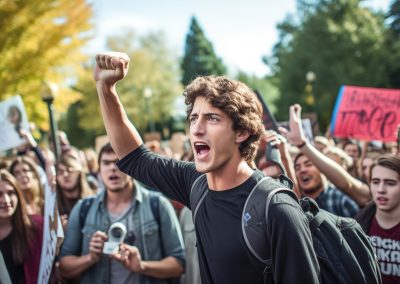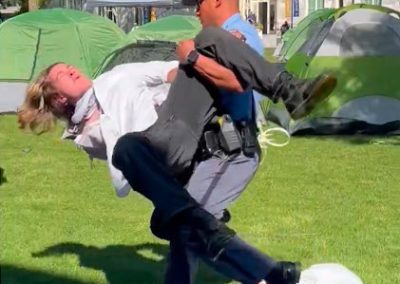A concept gaining steam but causing confusion, angst, and anger…
It’s interesting–and sad–that when a police shooting makes national news, the term “police violence” is almost always used.
People look for any opportunity to place blame on law enforcement. They dissect the videos and point to anything that can transfer blame from the perpetrator to the police. We hear things like…
“He used no de-escalation tactics before he shot!”
“She didn’t need to have that tone in her voice!”
“The police have no business getting involved in such a small [crime…traffic violation…quality of life issue…]!”
“If the officer would have said this or that, then the man wouldn’t have charged with a knife.”
“The Police Shoot 50,000 People a Year”
An audio/visual tech at a venue where I was teaching a couple of years ago asked me once how we could “cut back on the number of shootings by the police.” Two things struck me about the conversation and his reaction at the end.
The first was his lack of concrete facts. When I asked him if he thought the police shot too many people, he responded with a confident, “Yes.” When I asked him how many people are shot annually by the 700,000 plus cops in over 17,000 agencies across 50 states his response was a more hesitant and muttered, “Well, I don’t really know.”
“But you think the police shoot too many people, right?”
“Yes.”
So, I asked the question I always ask, “How many do you think we shoot?”
He said, “Well, my friend was shot and killed last year by the cops in Colorado.”
He told me that his friend was shot over 20 times and it was on video. So, we looked it up, right there on the spot. Turns out his friend pulled a gun on two officers on a traffic stop, fired, ran and was shot a total of four times and it appeared as though the two officers fired no more than 2-3 rounds apiece.
“Oh, I was given bad information, but shouldn’t they have warned him before they shot him?”
We watched it again and afterward, he admitted, “Yeah, I guess they didn’t have a chance to warn him.”
I then said, matter of factly as I was setting up my computer for the class, “You know, 987 people were shot and killed by the police last year, and your friend happened to be one of them.”
Startled he said, “What do you mean 987? You talking about Colorado?”
“No, the entire United States.”
No, that can’t be right.”
I asked him, “What do you mean?”
“It’s got to be more than that!”
“How many people do you think the police shoot every year in this country?”
“I dunno, maybe 50,000.”
I laughed because I’ve heard guesses that reach over 100,000.
“Nope. Check the Washington Post. They track the numbers. Been doing that since 2015. The number has never been over 1,000 people fatally shot in one year.”
“Wow,” he said, “I had no idea.”
Which brings me to the second thing that caught me about his reaction and belief system.
He asked me a couple of other questions as we waited for my computer to boot up.
“Well, what do you think the common denominator is when it comes to who the police shoot? Is it race? How can you get that number even lower?”
I told him that both of those questions have the same answer, “Do what the cop asks. If people didn’t resist, pull weapons, complied with orders and did what they were asked and told, the number would be close to zero.”
“Huh. Yeah, I guess that’s true isn’t it.”
Reasonable vs. Avoidable?
Seth Stoughton, Associate Professor of Law at the University of South Carolina and former police officer, addresses issues concerning police and their use of force.
He wrote in an article a few years back, “When cops evaluate a use-of-force incident, they ask whether it was justified, focusing on the legal rule set by the Supreme Court in the 1989 case Graham v. Connor.”
He continued. “When civilians evaluate a use-of-force incident, they ask whether it was avoidable. They want to know whether the officer could have done something—anything—else.”
Police officers, in general, get really frustrated over that type of rhetoric…the questioning of whether “the officer could have done something—anything–else.”
Cops universally believe what I told the AV tech; “If people would just do what the cop says, nobody would get shot.”
Makes sense. Hard to argue with. Unless, of course, you’re looking for an argument and are a diehard cop hater.
Should We Address Officer Behavior?
Calibre Press offers a course titled, Legally Justified, But Was it Avoidable?
It’s extremely popular, selling out at most every venue and the class is populated completely by police officers, over 60% of whom are supervisors.
The title, though, has angered a few to the point that they have written Calibre Press. Their argument is something we address in our marketing material and at the beginning of class: The Graham decision prohibited the use of the 20/20 vision of hindsight. In other words, the post-incident critique is not to be based on how the moment came to be. It’s to be based on what was happening in the moment and a consideration of whether the officer’s force decision was objectively reasonable in that moment.
As one of the officers who wrote to me said, “We can’t be second-guessing the police on what they should have said or done. That’s hindsight that opens a can of worms.”
And I totally agree; from a legal standpoint.
I firmly believe the Graham Standard is judicious, sound and should never be changed or overturned.
But to never analyze an event and look for training opportunities it may yield, or to ask what could have been done to prevent that moment from ever developing is nonsense. We should, for many reasons—without disparagement—learn so other officers have the benefit of considering options that may have prevented the moment…a moment that changes lives for everyone, involved including the officer.
For us in the profession to avoid discussing options, to forego evaluation of how officers performed and decided under stress, to turn a blind eye to poor training and leadership cultures that contributed to avoidable moments? That would amount to professional nonfeasance.
Crazed Man with a Knife
Case in several points: Ansonia, Connecticut.
A woman went to the police department and reported that her crazed ex-boyfriend was in her house. He was on a no-contact protection order and had a history of threats and abuse.
The police responded and found the 30-year-old man in the house, apparently alone. He told the police numerous times that they would have to shoot him as he continued to brandish a knife he was ordered to drop. When officers asked him to talk with them, he shut the exterior door and the police kicked it in.
After the officers entered the residence, they asked him to step out of the house and to put the knife down several times. They didn’t swear at or threaten him.
The man ran into a bedroom and shut that door. Three officers moved toward the door and it appears that at least one, if not two of them, took out tasers while the other officer kept his handgun out and ready. They moved close to the door and put themselves in harm’s way, intending on using a Taser against a deadly weapon.
From inside the room, the man yelled, “I’m takin’ one of y’all with me! Yer gonna have to shoot me!”
They kicked in the door and immediately used a taser, and as often happens, it had no effect on the man. Seconds later, as officers again pleaded with the man to comply with their orders, he charged them with the knife yelling, “Shoot me!” and they did, fatally, just a few feet away from an officer.
Immediately an ACLU representative made a public statement about the officers.
“It seemed like at every turn police escalated the situation,” said David McGuire, executive director of the American Civil Liberties Union of Connecticut. “It begs the question: How many people have to die at the hands of police until there are meaningful systems to deal with people in crisis?”
As I said, case in several points.
The first: This man died because he refused to obey the officers.
He charged them with a knife. He created the situation and the moment, which he generated the second he refused to obey and charged the officers with the intent to kill.
At every turn, Mr. McGuire, these officers proved beyond a shadow of a doubt that they did not want to shoot this man. In fact, Mr. McGuire, these officers were willing to risk their lives – their lives — to save this man. They got way too close in an effort to use a less-than-lethal weapon on a man armed with a very deadly weapon.
These are brave police officers who proved by their actions everything I just wrote.
There’s a second.
We can still learn from this encounter. The officers were brave, they were committed to do their job and put themselves at risk to save a crazed stranger.
That said, were there, in complete hindsight, other options?
— What is your best defense against an edged weapon? Distance and barriers. Did the officers have opportunities for both of those?
— Were any other people in the house and in immediate danger?
— What was the need to arrest the man at that particular point?
— While in a highly agitated and threatening state was there a need to move in on him, to control him right then and there?
— Did he give any indication he wanted to be shot by the police?
— Was he exhibiting recognizable signs of possible mental illness or emotional instability that may be contributing to the pressurization of the situation?
— Was isolating himself in a room a way to safely contain him?
— Was there any conversation about other options besides kicking in doors and moving towards?
I don’t know the answer to some of those questions, but isn’t it necessary to ask them and discuss? To process and consider as professionals?
Again, my point is not to disparage but to reflect as most officers do after an encounter like this.
It is very easy to Monday-morning-quarterback, free of stress and danger. While he brings up a point for discussion, Mr. McGuire appears to have no sense of what these officers were experiencing. He just blames and vilifies the officers personally while casting aspersions on the profession and advancing a false narrative about the numbers of unwarranted police shootings.
In my opinion, and it’s just my opinion, McGuire doesn’t seem at all interested in a discussion on the reality and complexity of such an event.
We in the profession have to rise above petty politics and activist agendas. We are civilian peace officers, members of the public, assigned an extraordinary responsibility. We should strive to be the best, learn from our experiences and the experiences of others, and look to improve constantly.
We in the police profession cannot insulate ourselves from the public, as much as we may want to, when we are given no quarter from those who hate and condemn. We must rise above.
***
Be sure to check out the popular new Calibre Press course, Legally Justified, But Was It Avoidable?










0 Comments